

 Vol. 39 (Nº31) Year 2018. Page 28
Vol. 39 (Nº31) Year 2018. Page 28
Maria V. GOLOVKO 1; Valentina A. RUDENKO 2; Nikolay I. KRIVOSHLYKOV 3
Received: 18/03/2018 • Approved: 01/05/2018
ABSTRACT: The article is devoted to the study of the evolution of mechanisms of ensuring economic development and safety of the nuclear power engineering enterprises in terms of changes in the external economic and political environment. The authors made an attempt to determine how institutional transformations have affected economic security and the choice of mechanisms and the directions of economic development of the of nuclear power engineering enterprises since the moment of their origin to the present based on official statistics, etc. |
RESUMEN: El artículo está dedicado al estudio de la evolución de los mecanismos de desarrollo económico y seguridad de las empresas de ingeniería de energía nuclear en términos de cambios en el entorno económico y político externo. Los autores intentaron determinar cómo las transformaciones institucionales han afectado el desarrollo económico de las empresas de ingeniería de energía nuclear. |
The tasks of searching for effective mechanisms for economic development and ensuring the security of industrial enterprises are now most relevant. There are no universal methods and instruments to influence the production and commercial processes of economic entities in order to improve economic results. The modern turbulent environment creates numerous threats to economic security and can devalue even the ideal strategy and development model. This problem is typical for the economies of all countries and is widely covered by domestic and foreign researchers (Askerov et al., 2016; Davis & North, 1970). At the same time, economic security can be considered through the ability of the socio-economic system (state, region, enterprise) to develop (Abalkin, 1994), and economic development through innovative activity of the state, region, enterprise, determining their competitiveness Freeman, 2005; (Kobryn, 2004; Lundvall, 1992; Nelson, 1993), through the stability potential of any economic system in relation to external threats, through the identification of regional and sectoral specifics (Mingalyova & Gershanyuk, 2012), etc. Special attention should be paid to works devoted to the analysis of economic security (Rudenko et al., 2017).
According to the authors of this article, economic security should be determined through the selection and use of effective tools for managing the resources of the economic system that are adaptive to the current state of the external environment. The uniqueness of each mechanism of economic development is its specificity and adequacy for an individual enterprise, taking into account the goals, opportunities, prospects, sector dynamics, regional specifics, the level of competition, the characteristics of cooperation ties, foreign economic strategy, etc.
Recently, special attention has been paid to the development of domestic nuclear energy, strengthening its export positions in the world market, taking into account the changing geography of foreign economic relations. This should form the interest of the scientific community to study the methods, mechanisms, strategies and problems of the development of industrial enterprises entering the industry, searching for effective ways to resolve them. This article considers the features of nuclear power engineering (NPE), which is the basis for creating production capacities of nuclear energy.
The formation of the NPE has not yet been completed, since this industry has undergone significant changes associated with the transformation of the institutional environment. Fig. 1 presents the calculations of the dynamics of the main indicators of the economic development of the industry.
The calculations lead to the conclusion about the following main stages of institutional reforms in the nuclear industry, which determine the pace of economic development of its members:
The specifics of the IENPE development fully reflect those institutional transformations of the macro environment that accompanied and predetermined the development of the national economy in the complex post-war and transformation periods. The development of nuclear power engineering in Russia was due to the intensification of research on the possibilities of using nuclear energy by the middle of the 20th century. The importance of the conducted sectoral studies and their results for the country as a whole, including its economic development and competitiveness in the world market, ensuring the defense capacity, and the level of possible security threats, predetermined the high degree of dependence of the trajectory of the industry development on the strategic landmarks of the state and government. This is evidenced by published documents and materials on the development and implementation of the nuclear project in Russia since the beginning of 1942 (Kudryashov, 2015).
Figure 1
Seasonal wave of butter and butter paste
production in Krasnodar region, 2011-2014
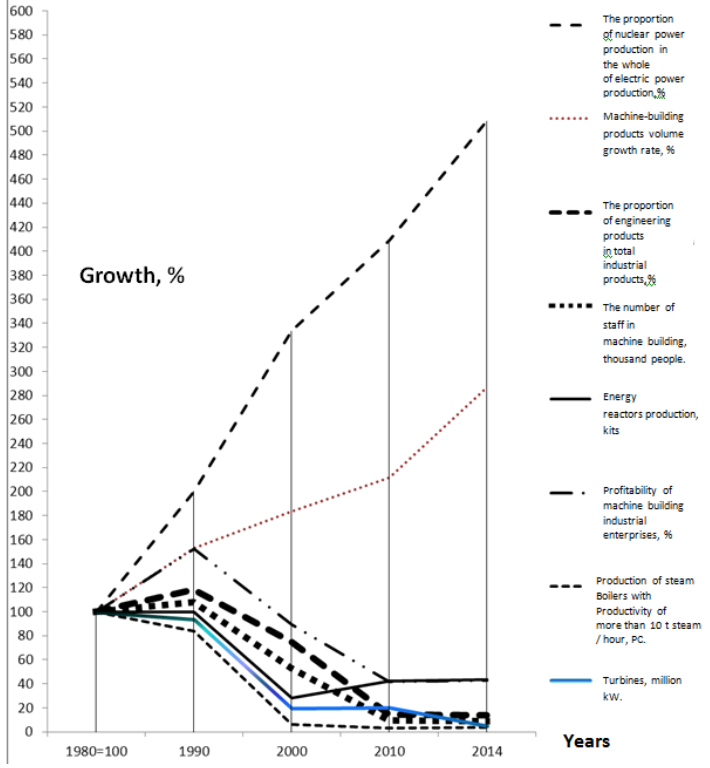
Source: Prepared by the authors
The aggravation of foreign policy relations after the Second World War, the buildup of the nuclear armament potential by the United States (USA), its demonstration in action (Hiroshima and Nagasaki) actualized the nuclear race for the USSR. The priority value of nuclear power for the Soviet period determined the specific role and status of the government in this area. In August 1945, an Ad Hoc Committee was established under the State Committee for Defense (GOKO) for the creation of nuclear weapons, it was subordinated to the First Main Directorate (PGU), organized under the Council of People's Commissars of the USSR (SNK of the USSR), for the direct management of R & D, enterprises and organizations for use of atomic energy. SC GKO was endowed with unlimited powers to regulate these issues, full control over the CCGT. The GKO Resolution No. 9887 cc / op “On the Special Committee under the GFCS” of August 20, 1945, at the GKKO SC was entrusted with the guidance on:
All expenses for R & D, as well as enterprises under its control and works performed by other departments on orders of the CCGT, were carried out at the expense of the Union budget, capital construction was financed through the State Bank, and registration of the CCGT staff and its subordinate institutions in financial institutions was not required. These features indicated the privileged position of the industry, the priority of all nuclear projects and a fairly liberal management style, as far as possible in the command-administrative economy.
Effective development of the industry requires appropriate institutionalization. As the tasks facing the nuclear industry become more complicated, the role and complexity of the state governance structure increases, the chronology of which can be briefly presented as follows:
Minsredmash of the USSR took a special part in the development of nuclear energy. The Ministry possessed a huge personnel, research, production, building potential and became, in fact, a “state in the state” (Voloshin, 2009). At the Minsredmash enterprises not only nuclear weapons of a wide range were created and reactors for nuclear power plants were built, but new research institutes were organized in which fundamental and applied research was conducted. Between 1970 and 1980, about one and a half million people worked in organizations and enterprises under the control of the Ministry of Medium Machine Building, 10 closed and several dozen open cities were built for the development of the nuclear industry, nuclear reactors, nuclear weapons, underwater reactors and surface ships, built nuclear power plants in the country and beyond.
In fact, Minsredmash worked on the principle of innovative triad, which proved to be effective for the nuclear industry (Golovko, 2016; Golovko et al. 2017; Nosova et al., 2016; Tyukavkin, 2013; Voronov, 2002), being its constituent element from the state. It included scientific research, design and survey institutes, higher educational institutions, numerous industries, factories and mines, and whole cities of closed type.
The further development of atomic energy and the use of atomic energy for peaceful purposes required the adaptation of industrial production to the requirements of the national economy. A special role in this was traditionally assigned to enterprises that produce means of production, i.e. industrial enterprises of the machine-building complex. As the main directions of the economic and social development of the USSR for 1986-1990, and for the period up to 2000, the energy engineering industry was challenged with organizing, in the shortest possible time, the development and production of power units with a capacity of 800,000 kW with fast neutron reactors, solving a set of scientific and technical problems associated with the creation of power units with a capacity of 1500 thousand kW with rectifiers on thermal neutrons and with a capacity of 1600 thousand kW by fast neutron reactors, to ensure the production of equipment for nuclear power plants. In this connection, tasks were set for the creation and development of the first stage of the heavy engineering plant in Volgodonsk, Rostov Region. The production capacities of the power engineering company allowed the annual production of eight water-cooled power reactors with a capacity of 1 million kW each (VVER-1000) and other equipment included in the nuclear installation - steam generators, nuclear reactor overloaders, separators, superheaters, biosecurity equipment, hydraulic capacities of the reactor core cooling system, protection management systems, etc. (up to 125 titles). A unique domestic and imported equipment (produced in Italy, Japan, Germany) was installed at Volgodonsk Brezhnev Production Association of Atommash Nuclear Power Plant (hereinafter: Atommash), the basis and the most important distinguishing feature of this industrial enterprise was the serial production of nuclear reactors, known as the “Atommash conveyor”.
The transformation period of the Russian economy has changed the trajectory of development of all economic entities, the problems of economic security have become more acute. Industrial enterprises of the AEM have differently involved in the process of institutional transformation, differently reacted to the action of such specific threats to economic security as the redistribution of property, the loss of the sales market and the reduction of the nomenclature of the issue, fluctuations in the exchange rate of the national currency, etc. For Atommash, they were largely negative; the preconditions for the reduction in production volumes were the freezing of nuclear power plants, economic reforms, parties of foreign manufacturers, low level of management adaptation to new market conditions. Since the 1990s, Atommash has stopped producing nuclear reactors and has been redeveloped to produce equipment for the oil and gas chemical industry. Data on the nomenclature of its production are presented in statistical reports for its new organizational and legal form, which is Energomash-Atommash Limited (Table 1).
In the period under review, Atommash's sectoral affiliation in ALCEA (All-Russian classifier of economic activities) was listed as “Provision of services for forging, pressing, sheet and sheet metal forming and sheet metal profiling” (ALCEA 28.40.1).
Table 1
Revenues of Energomash-Atommash Limited in 2004-2009, by type of activity, thousand rubles.
Name |
2004 |
2005 |
2006 |
2007 |
2008 |
2009 |
Special equipment for nuclear power plants |
54 500 |
63 |
0 |
0 |
0 |
283 100 |
Oil and gas processing special equipment |
275 300 |
283 000 |
224 600 |
306 800 |
0 |
0 |
Chemical equipment and spare parts for it |
0 |
0 |
0 |
0 |
644 100 |
692 600 |
Source: (JSC Interfax-South SPARK).
At the same time, Atommash has become a kind of personnel, technical, and technological “donor” for the development of enterprises of nuclear power engineering in the territory of Volgodonsk. Special attention should be paid to the basic institutional transformations of the former structural subdivision of Atommash, the modern industrial enterprise of OJSC “Atommashexport” (Table 2).
Table 2
The basic institutional transformations of OJSC “Atommashexport” from 1977 to 2006.
Stages |
Organizational and legal form |
Main activities |
1977 – 1984 |
Atommash structural subdivision |
the functions include supervised installation of machine tools, carried out by foreign specialists, the translation of accompanying documentation from foreign languages, the provision of foreign economic activities (foreign trade activities) of the enterprise (export and import). |
1984 - March 1995. |
creation of a self-supporting foreign trade company “Atommashexport”, then the creation of OJSC “Atommashexport” |
the implementation of foreign trade activities, the provision of engineering services, the transition to rental relations. A significant number of Atommash specialists came over to OJSC “Atommashexport”. |
April 1995 – 2006 |
OJSC “Atommashexport: |
the development of production capacities, the expansion of the range, the range of engineering, marketing, barter, intermediary and other types of services, operations with securities. |
From 2006 to the present |
OJSC “Atommashexport”, transformation in accordance with changes in legislation in Atommashexport JSC, in 2016. the beginning of work on the formation of a territorial cluster of nuclear power engineering (TCNPE) |
Further development of the economy and production, including foreign trade activities. Integration into territorial cluster makes it possible to increase the volume of orders, establish long-term relationships with counterpart partners in the cluster. |
Source: Prepared by the authors.
We consider it necessary to note that the main factor of economic security of enterprises in the transformation period has become effective management and situational approach, focused on the choice of mechanisms for economic development in accordance with the specifics and main trends of the national economy. The analysis of the stages and results of the development of the JSC “Atommashexport” company allows us to confirm this conclusion and note the main factors and tools that served as the basis for its stable economic development in the specified period (unlike Atommash and other IENPEs created on its assets).
First, the great experience and a high level of qualification of employees of JSC “Atommashexport”. Secondly, the introduction of elements of intra-farm accounting for the divisions of the JSC “Atommashexport”. Thus, along with the basic part of the salary, established in accordance with the tariff, employees of the enterprise can receive bonuses depending on the results of the work of the unit. The factor of successful implementation of the self-supporting approach was competent management and serious continuous monitoring of all production and economic processes, which allowed timely making the necessary adjustments, obtaining objective information about the activities of the enterprise and the contribution of the department and production.
Thirdly, already today, through the introduction of an automated enterprise management system, maximum transparency in the process of making managerial decisions was achieved, which remains a factor in the efficiency and security of the economic development of economic entities. In this case, the main contradiction of management is overcome - alienation of control objects from the process of development and implementation of management decisions (Golovko, 2016; Nosova et al., 2016).
The company has created a unique program for the automated management of the “Integrated Business Environment Organization (ISOD)” enterprise (Figure 2).
Figure 2
Information environment of JSC “Atommashexport”, integrated and management of the ISOD software complex
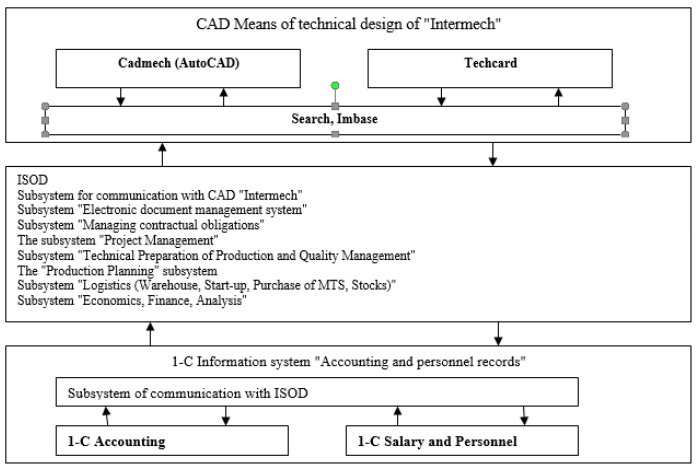
Source: Prepared by the authors.
This system is used to perform management procedures at all stages and stages of the life cycle of products manufactured by JSC “Atommashexport” (Figure 3).
Figure 3
Key processes of JSC “Atommashexport” life cycle
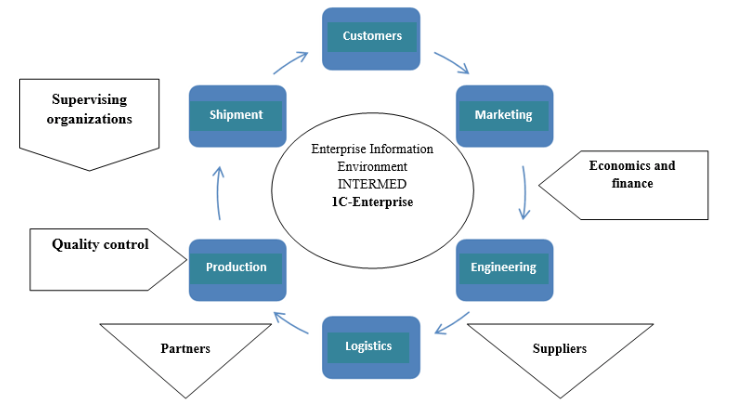
Source: Prepared by the authors.
Actual economic performance of JSC “Atommashexport” is at a level equal to and above the average industry indicators (Table 3, Figure 4), which indicates the continued effectiveness of management and the adoption of correct management decisions in accordance with changing environmental conditions.
Table 3
The main economic results of JSC “Atommashexport” activity for the period of 2011-2015.
Name |
2011 |
2014 |
2015 |
Growth rate 2015 to 2011, % |
Revenues |
878 921 |
2 625 319 |
2 277 355 |
159,1 |
Cost price |
640 475 |
2 175 244 |
1 702 037 |
165,7 |
Gross profit |
238 446 |
450 075 |
575 318 |
141,3 |
Profit before taxes |
69 001 |
232 817 |
284 464 |
312,3 |
Net profit |
53 315 |
191 274 |
231 950 |
335,1 |
Source: Prepared by the authors.
The dynamics of revenue and profitability of JSC “Atommashexport” in comparison with industry average values is shown in Figure 4.
Figure 4
Revenues and profitability of JSC “Atommashexport” for the period of 2011-2015 in comparison with the average industry values
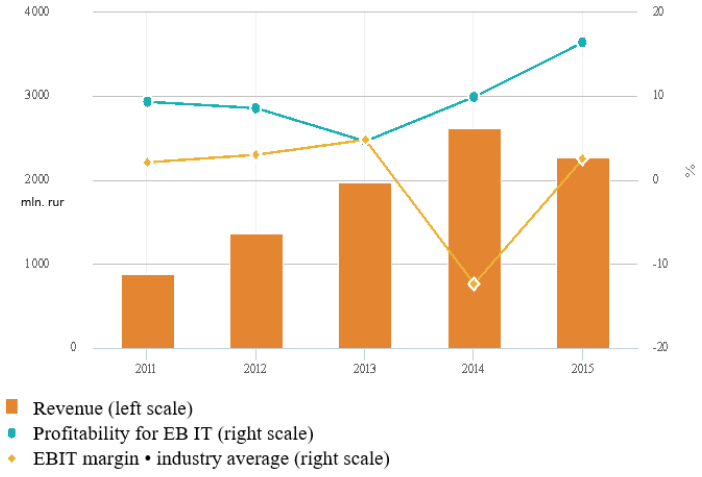
Source: Prepared by the authors.
At the same time, there is a drop in revenue in 2015 compared to 2014, which is typical for the majority of IENPEs, and the general economic and political trends are generally unfavorable. In this regard, it is necessary to determine the strategic vector of economic development taking into account the current situation and possible consequences.
Modern mechanisms of economic development of the nuclear energy machine building enterprise of JSC “Atommashexport” are in many respects related to the features of the territory on which it is located (Volgodonsk, Rostov Region). Historically, the city developed in parallel with the construction of Atommash and the Rostov Nuclear Power Plant (RoAES). This is the reason for the professional-qualification specificity of labor resources, as well as the creation in the period 1990-2000. many small and medium-sized enterprises directly or indirectly related to nuclear power engineering (Polesie Limited, MTM LImited, JSC “Atompspetservis”, JSC “Atommashexport”, etc.).
In 2009, on the basis of the branch of the South-Russian State Technical University “Novocherkassk Polytechnic Institute”, the Volgodonsk Engineering Technical Institute was opened, the branch of the National Research Nuclear University “MEPhI” (VITI NRNU MEPhI), which provides training for the nuclear industry. Thus, in the city of Volgodonsk the “nuclear” specialization was set.
The sphere of Russian nuclear power engineering is represented by a combination of industrial enterprises with various organizational and legal forms, scope of activities, level of specialization, and the breadth of the production mix. The largest business units are gradually being integrated into the engineering contour of the SC Rosatom, acquiring a number of advantages and assuming certain obligations. The creation of the SC Rosatom and the formation of various divisions, including machine-building, in its structure, activated the recovery growth of the industry. Only Atommash joined the group of companies of the engineering division of JSC “Atomenergomash” in the Volgodonsk IENPE.
According to the laws of economic development, the tendencies of integration are objective and aimed at ensuring the stability of unifying subjects. As a result of the analysis and assessment of the current external economic situation, trends and opportunities, small and medium-sized enterprises of nuclear power engineering in Volgodonsk came to an agreement on the creation of a territorial cluster of nuclear power engineering (TCNPE) (Figure 5). The effectiveness of the cluster approach for the development of the regional economy has been proved in the works of many Russian and foreign scientists (Tyukavkin, 2013).
The TCNPE of Volgodonsk will have about 20 participants, among which JSC “Atommashexport” (which becomes the core of the cluster), Polesie LImited, MTM Limited, NRNU MEPhI, NGO Union of Industrialists and Entrepreneurs of Volgodonsk, banking structures, etc.
Figure 5
Algorithm for creating TCNPE in Volgodonsk
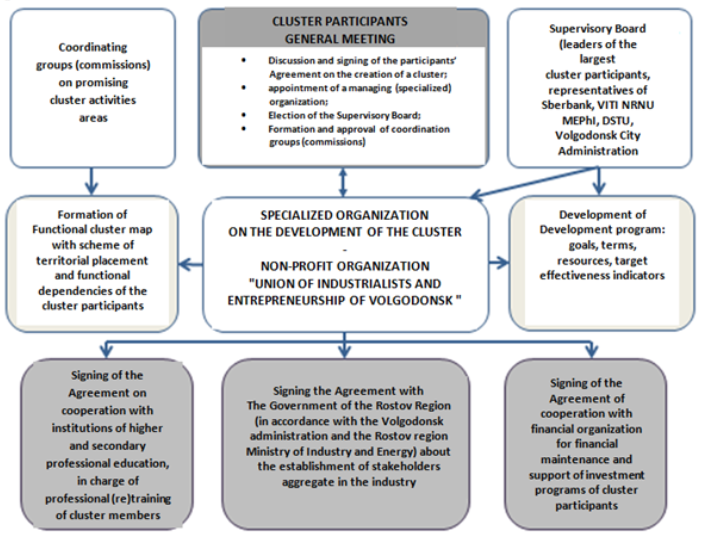
Source: Prepared by the authors.
The authors of the article see the possibilities of TCNPE for small and medium-sized enterprises of nuclear power engineering industry as follows:
At the first approximation it may seem that the enterprises should unite in order to enter the contour of the SC Rosatom. However, the need for the existence of small and medium-sized enterprises in the field of nuclear power engineering lies in the fact that they produce the range of products that is unprofitable for large enterprises, for giants like Atommash (currently a branch of JSC “AEM-technology “Atommash” in the city of Volgodonsk). As a result, customers who do not need large volumes, objects, it will be more profitable to find cluster formations for the production of the nomenclature that they need. At the same time, large enterprises of nuclear power engineering can interact with small and medium-sized enterprises of nuclear power engineering, giving unprofitable products for outsourcing.
The creation and development of the cluster will favorably affect the development of industrial enterprises, leading to growth:
A lot of work has been devoted to determining the methodology for assessing the economic efficiency of a cluster. The authors, as a rule, agree that the dynamics of the two main factors of production - labor and capital - are subject to evaluation, and they propose to consider labor productivity, industrial output, share of exports, etc. (Kurnosova, 2015; Tretyak, 2017; Voronov, 2002; Zhdanova, 2008). The positive dynamics of these indicators will indicate the effectiveness of the cluster, however, it should be supplemented by an analysis of private indicators that reflect the results of its individual participants. At the same time, there are clusters that include educational organizations in the membership, which determines the need for adjusting the evaluation model, taking into account their specifics.
Analysis of institutional factors that influenced the development of industrial enterprises of nuclear power engineering industry showed the following. The major part is taken by the state policy in the nuclear industry due to its strategic importance for ensuring not only the defense capability, but also the economic security and economic development of the state. The presented periodization of the main stages of institutional reforms in the nuclear industry confirms their influence on the pace of economic development of enterprises of nuclear power engineering.
A specific factor of economic development, based on a concrete example, is effective corporate management. In particular, the creation of a territorial cluster of nuclear power engineering is relevant for small and medium-sized enterprises in a particular territory. That is why the assessment of modern mechanisms of economic development should be conducted taking into account its adequacy to institutional reforms in the domestic and foreign markets.
Abalkin, L.I. (1994). Economic safety of Russia. Treats and their reflection. Issues of economics, 12, 4-13.
Askerov, P.F., Novichkov, A.V., Novichkov, V.I., Nosova, S.S. & Rabadanov, A.R. (2016). Turbulence in the Russian Economy Management System. International Journal of Economics and Financial Issues, 6(S1), 233-238.
Atomic project of the USSR: documents and materials, 1, 1938–2010. (1998). Moscow: Nauka, Fizmathlit.
Davis, L. & North, D. (1970). Institutional Change and American Economic Growth: A First Step Towards a Theory of Institutional Innovation. The Journal of Economic History, 30(1), 131-139.
Freeman, C. (1995). The National System of Innovation in Historical Perspective. Cambridge Journal of Economics, 19, 5-24.
Golovko, M.V. (2016). The development of a culture of economic security as a tool to combat the rent-oriented shadow economy. Modernity: economic algorithms and practices. Moscow, Tambov: Publishing House of Derzhavin TSU.
Golovko, M.V., Antsibor, A.V., Zhuk, A.V. & Zheleznyakova, A.V. (2017). Institutional determinants of economic development of industrial enterprises of nuclear power engineering in the 1950s - 2010s. Economics and Entrepreneurship, 7(84).
Kazancev, S.V. (2012). Economic security and competitiveness of Russian Federations subjects: factors and assessments. Regions of Russia: Strategies and Mechanisms for Modernizing Innovative and Technological Development. Proceedings of the Eighth International. Scientific and practical. Conference, 1. Moscow: RAS, INION, Department of scientific cooperation and international connections, 74-78.
Kobryn, Y. (2004). Innovations as a condition of competitiveness. Economist, 12, 23-29.
Kudryashov, N.A. (2015). Discoveries in physics and the creation of nuclear weapon. Moscow: NIYaU MIFI.
Kurnosova, E.A. (2015). Estimation of the efficiency of functioning of aerospace clusters. Bulletin of the Samara State University. Series Economics and Management, 9(131), 97-105.
Lundvall, B.Å. (1992). National Innovation Systems: Towards a Theory of Innovation and Interactive Learning. London: Pinter.
Mingalyova, J.A. & Gershanyuk, G.A. (2012). Sustainable development of the region: innovation, economic security, competitiveness. Economy of the region, 3, 68-75.
Nelson, R.R. (1993). National Innovation Systems: A Comparative Analysis. New York: Oxford University Press.
Nosova, S.S., Mackulyak, I.D., Lyubimtseva, S.V., Askerov P.F., Shkalaberda, L.I. & Aliev, U.T. (2016). New management model of modern Russian economy: Regional aspect. International Review of Management and Marketing, 6(6), 21-26.
Rudenko, V.A., Golovko, M.V., Tomilin, S.A. & Marchenko, A.A. (2017). Project of multi-purpose research nuclear installation on fast neutrons is to ensure the national economy safety. ARPN Journal of Engineering and Applied Sciences, 2.
Tretyak, V.P. (2017). Clusters of enterprises: ways to create and operate. Retrieved from URL: http://www.subcontract.ru.
Tyukavkin, N.M. (2013). Methods for assessing the efficiency of clusters in industry. Fundamentals of Economics, Management and Law, 3(9), 109-113.
Voloshin, N.P. (2009). To the history of the domestic atomic project: a course of lectures for students of educational institutions of “Rosatom”. Moscow: IzdAT.
Voronov, A. (2002). Clusters as a new form of industry self-organization in a competitive environment. Marketing, 5(66), 37-43.
Zhdanova, O.I. (2008). Cluster as an instrument of industrial policy of the region. Economics and Management, 9(66), 60-67.
1. Volgodonsk Institute of Engineering and Technology branch of National Research Nuclear University MEPhI (Moscow Engineering Physics Institute), Moscow, Russia, E-mail: golovko178@mail.ru
2. Volgodonsk Institute of Engineering and Technology branch of National Research Nuclear University MEPhI (Moscow Engineering Physics Institute), Moscow, Russia
3. JSC “Atommashexport”, Volgodonsk, Russia